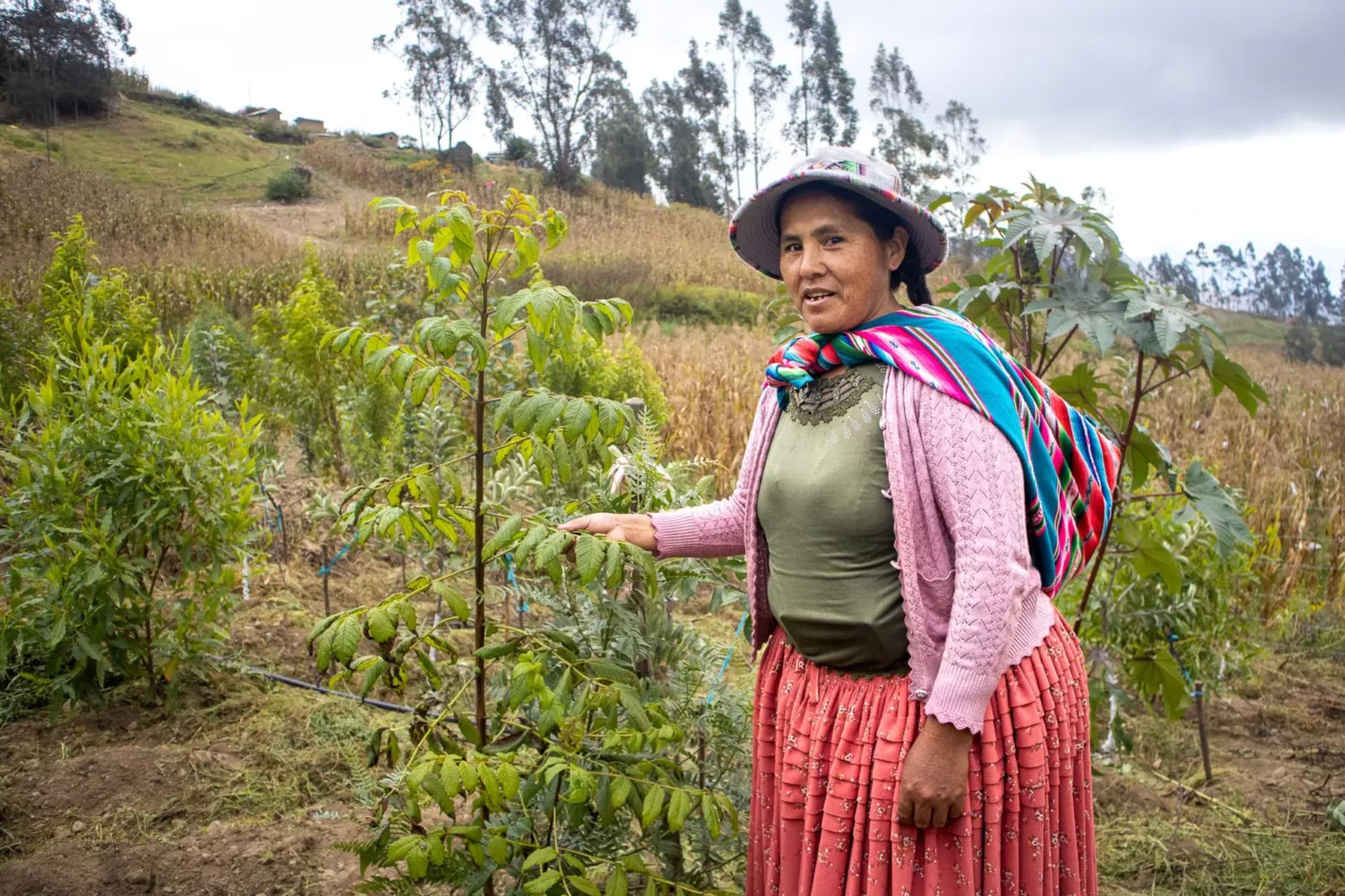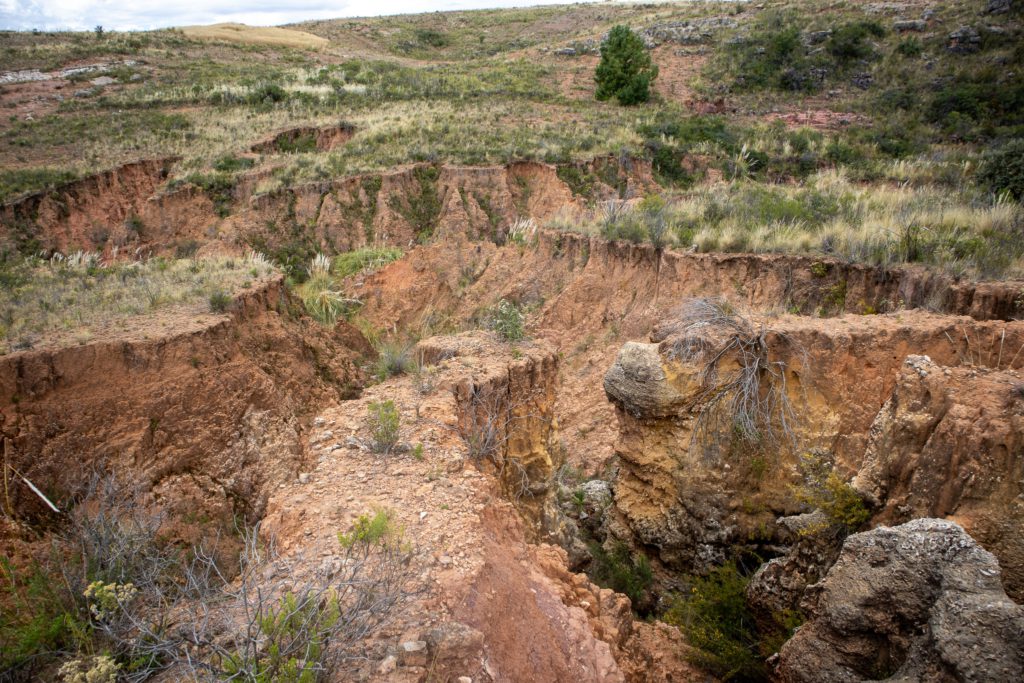Project visit to Bolivia: thanks to trees, water returns to the Andes
22 July 2024

22 July 2024
“Agua es vida”, that is: “Water is life.” During our project visit to Bolivia, we came across this statement at least once every day. Fact is that water shortage is of the order of the day in the Andes mountain range. That is why here we support a Samay Foundation project, in which we plant trees together with the local population in order to improve the availability of water. For four days on end we travelled at altitudes of thousands of meters in order to see how the trees were doing – and the water!
Trees for All has supported the plantation of trees in the Bolivian Andes since 2022. This is urgent, as we experience when German, local project coordinator for Samay Foundation, takes us to visit various planting locations in the Andes mountain range.
Although our surroundings seem green enough at first sight, much of the original nature has disappeared as a result of agriculture and animal husbandry. In combination with climate change, this causes the area to dry out. Because of a lack of trees, water is not able to seep through into the soil, which in its turn becomes drier and drier and water shortage arises.
Its consequences are clearly visible, e.g. where in spots where erosion has split the soil in two. Naturally, its impact on humans and nature is gargantuan, so German tells us. But there is hope: by planting trees we may stimulate the availability of water to increase!

Intensive agriculture and animal husbandry have caused erosion and deep trenches, as in this area in the Cochabamba region.
German is daily in charge of six smaller organizations which set the local population on their way to planting trees. This is done in two ways. One approach is for the village communities to plant trees on deforested mountain slopes. To be precise, in water retention areas: sites where rainwater collects naturally. By planting trees in exactly these sites, the availability of water increases. Besides, people build water reservoirs which collect and store rainwater.
The other approach is for the residents to make their own ground more sustainable by switching to agroforestry, a sustainable alternative to traditional agriculture. People plant (fruit) trees in combination with other crops, such as vegetables and fruit. This approach provides more fertile soil, improved water quality and more, variegated food. Ans at least equally important: this diminishes the need to cut more trees to make room for agriculture and animal husbandry.
We are curious to learn how this theory works out in reality. For how do you motivate people to plant trees? And how do you make sure that they are going to pant the right tree in the right place?
To see this, German takes us to a model farm in the Cochabamba area. What we see there is impressive. On the grounds around the farm, water infiltration areas and reservoirs have been imitated. Communities and farmers from the surroundings may take classes here in order to learn how it is done: building a reservoir or collect water.
Also, an agroforestry-plot has been laid out, in which all sorts of indigenous trees, fruit trees, shrubs and other crops grow and bloom. The site looks enormously much greener and more varied than the neighbors’, where there is only corn. This makes it a splendid source of inspiration for people to switch to forest farming themselves.
There is no shortage of inspiration here, for that matter: the people are highly conscious that they are in dire need of trees. In their own words: “No trees, no water and no life!”
Photo 1: German (middle) with our colleagues at the model farm in Sipe Sipe
Photo 2: An agroforestry-lot to inspire local communities and farmers
In the next few days it becomes obvious that the model farm concept yields its result in practice. We visit several water infiltration areas near Cochabamba (Sipe Sipe) and La Paz (Sorata). At Sipe Sipe a 300-family-community planted some 9,000 trees along deforested mountain slopes, also thanks to our support. Because everybody lent their hands, the job could be finished within just a couple of days.
Photo 1: Proud Bolivians who helped planting and hold baby trees.
Photo 2: One of the slopes we reforested, together with local residents.
Photo 3: Marcelina, one of the tecnicos who support the communities when planting.
Those very people have built a reservoir further down which will hold 833,000 liters of water. About 300 families will fetch their water from here in order to run their households and irrigate the newly planted trees. Thanks to the reservoir, people no longer need to travel into the mountains with donkeys and buckets in order to collect water at high altitudes. A large step forward.
In the next few years they are going to plant another 10,000 trees along minor rivers in this area, in order to improve water retention there as well. Talking about community power!
From left to right: several water reservoirs
All of these days we find ourselves at an altitude of 3,000 meters; a height at which not all trees survive. For that reason only types are planted which prosper at such altitudes, such as kewiña and kiswara. In every water infiltration area severe rules apply as well, in order to make sure that water and nature start to move again. Agriculture and animal husbandry, for example, are not allowed.
The effect of these agreements can be seen further on. Ground which eight years ago was totally barren as a result of agriculture, now has plenty of young trees and shrubs showing their heads above the surface! Besides, natural regeneration will manifest itself thanks to he trees the population is going to pant here in the next couple of years.
The most beautiful of all? Little by little the water is returning! The speed at which the water streams has visibly increased from 2.5 cubic meters per second in 2017 to 3.5/second in 2023. A sign of hope in a region which is getting drier and drier.
Photo 1: One of our colleagues with a tree which was planted about a month ago.
Photo 2: At the dividing line between degraded soil (left) and natural regeneration (right).
Apart from water retention areas we visit several agroforestry lots owned by farmers and local communities. Proudly they show us their lots, where all sorts of vegetable, fruit and other crops grow among indigenous trees. An impressive sight to see: some of the (fruit)trees have been growing for just eighteen months and reached heights of several meters. The summit is a lot which was barren two years ago and is now filled with blossoming (fruit) trees!
Apart from the population’s intrinsic motivation, this kind of success is due to the support they receive from German and his teams. So-called ‘tecnicos’ help people on their way with know-how and hints about plantation and management of trees. The variety in crops makes people less dependent on the harvest of one crop. And trees and crops serve to have fertile soil holding water better, CO2 absorption and more biodiversity.
Women from village communities show us around their agroforestry lots.
After three to seven years the effect of the plantation for the water management will be well measurable. Then the people in the region will experience the growing increase of water availability. Expert help will be hired to monitor the expected increase. And in the meantime? We will continue this successful project as an example for numerous people and organizations worldwide!
Thanks to your gift we will be able to help many more Andes residents with reforestation and agroforestry. That way we will bring back the green and the water – step by step!
Plant a tree